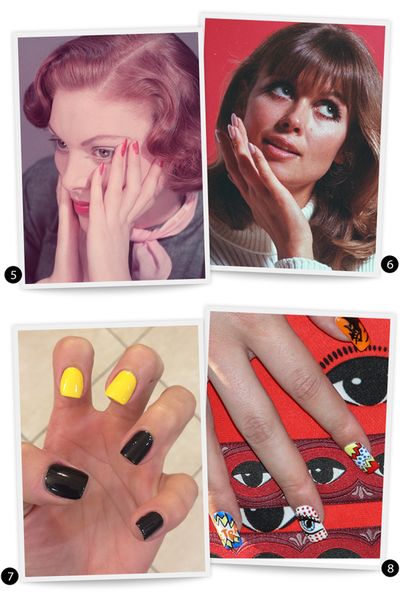Telling Talons: The History of the Manicure
Look back on the manicures of yonder.


1. The Ancient Babylonian's Good as Gold Manicure, 3500 B.C. - 1781 B.C.:
Ancient Babylonian men manicured and colored their nails using kohl, with different colors representing different classes. The upper echelons wore black while the lower classes wore green. They also created the world's first, and most lavish, manicure set — the tools were made from solid gold! Kelly Osbourne and her $250,000 manicure have nothing on these guys.
2. The Ancient Egyptian's Scarlet Manicure, 1300 B.C. - 1st Century B.C.:
Cleopatra and Queen Nefertiti, pioneers of all things opulent, popularized the manicure by rubbing their hands in rich oils and staining their nails using henna. They believed that this signified their wealth and status. The bolder the color, the more power you had. Cleopatra preferred a blood red hue, while Nefertiti opted for ruby. We're going to go ahead and call red the official shade of sovereignty la pyramids.
3. The Ming Dynasty's Man-icure, 1368–1644:
Like the Chinese royals who came before them, both male and female members of the Ming Dynasty had perfectly manicured, talon-like nails. To add a tint, they mixed together egg whites, wax, vegetable dyes, and other materials to create different color varnishes ranging from dark red to black.
4. The Roaring 1920's and 1930's Manicure:
Get exclusive access to fashion and beauty trends, hot-off-the-press celebrity news, and more.
As the automobile industry flourished in the '20s, women began to color their nails using high-gloss car paint. In 1932, Revlon launched a groundbreaking polish that used pigments instead of dyes and was available at drug stores. Flappers and silver screen actresses helped popularize the half moon technique, as well as the French manicure.

5. The Saucy 1940's and 1950's Manicure:
In the '40s, average women began to paint their nails at home, as well as visit the nail salon for manicures and newly minted acrylic nails. As Hollywood moved from black and white to Technicolor films, screen sirens like Elizabeth Taylor and Rita Hayworth inspired a bright red nail trend with their saucy pointed talons.
6. The Mellow 1960's and 1970's Manicure:
By the time the '60s came around, nail varnish hues mellowed out (hello hippie movement!) with pastel shades. French manicures also experienced a revival thanks to Jeff Pink, the founder of ORLY, who used it as a practical nail style for the Parisian runways.
7. The More-is-More 1980's and 1990's Manicure:
Nail art was born in the more-is-more '80s, as there was more experimentation with colors, prints, textures, and embellishments. Manicurists also filed nails into squares as opposed to the more traditional almond shapes. As grunge took hold of the '90s, men and women alike began to paint their nails in dark hues such as deep purple and black.
8. The Endless Possibilities of the 2000's Manicure -
The last decade has birthed all kinds of manicure trends (from au natural to 3D nails) as well as dedicated nail art salons and artists. With polish coming in virtually every color and new technologies, such as nail appliqués and semi-permanent gel varnish, the manicure possibilities are endless.
Lauren Valenti is Vogue’s former senior beauty editor. Her work has also appeared on ELLE.com, MarieClaire.com, and in In Style. She graduated with a liberal arts degree from Eugene Lang College, The New School for Liberal Arts, with a concentration on Culture and Media Studies and a minor in Journalism.